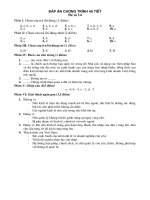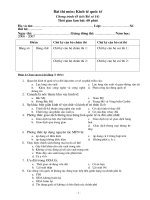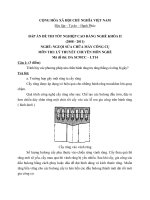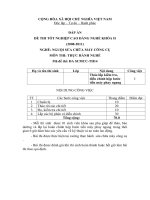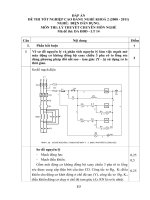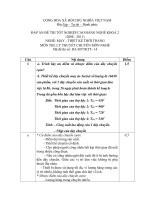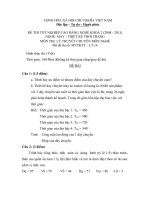14 asymmetric allylation reactions
Bạn đang xem bản rút gọn của tài liệu. Xem và tải ngay bản đầy đủ của tài liệu tại đây (1.37 MB, 16 trang )
Myers
Chem 115
Asymmetric Allylation Reactions
Brown Allylation and Crotylation Reactions
Enantioselective Allylboration
Et2O
–78 A 23 °C;
O
Reviews:
H + (–)-Ipc2B
R
R
NaOH, H2O2
Srebnik, M.; Ramachandran, P. V. Aldrichimica Acta 1987, 20, 9.
R
Roush, W. R. In Comprehensive Organic Synthesis, Trost, B. M.; Fleming, I., Eds., Pergamon
Press: New York, 1991, Vol. 2, pp. 1-53.
Synthesis of B-Allyldiisopinocampheylborane
H 3C
CH3
CH3
CH3
CH3
=
(1R)-(+)-_-Pinene
91.3% ee
H3B•S(CH3)2
THF, 0 °C
h,72%
72 h,
72%
BH
BH
(–)-Ipc2BH
CH3OH, 1 h
0 °C, 100%
yield (%)
ee (%)a
ee (%)b
CH3
74
93
99
n-C3H7
71
86
-
n-C4H9
72
87
96
t-C4H9
88
83
99
C 6H 5
81
96
96
aAllylboration carried out without filtration of
Mg salts. bAllylboration carried out at –100 °C
under Mg-salt free conditions.
2
98.9% ee
OH
• The reaction is quite general; the stereochemistry of the addition is the same in all cases
examined.
• Lower reaction temperatures (0 A –78 A –100 °C) lead to increased enantioselectivity.
CH3
BB
CH3
MgBr
2
98.9% ee
BOCH33
BOCH
2
–78 A 25 °C
25 °C, 1 h
98.9% ee
• Only Mg-salt free reagent can be used at –100 °C because the reactive borane is
sequestered by ate complex formation with CH3OMgBr at this temperature.
• Allylboration of aldehydes is essentially instantaneous at –78 or –100 °C in the absence of
Mg salts.
• Prolonged incubation at 0 °C affords enantiomerically enriched Ipc2BH. This is due to
equilibration of tetraisopinocampheyldiborane with _-pinene and triisopinocampheyldiborane; the symmetrical dimer crystallizes preferentially.
H 3C
H 3C
• Both enantiomers of _-pinene are commercially available and inexpensive.(Aldrich:
(1R)-(+)-_-pinene, 91% ee, $100/500mL; (1S)-(–)-_-pinene, 87% ee, $42/100mL).
• B-Allyldiisopinocampheylborane can be prepared and used in situ after filtration of
the magnesium salts produced during its formation.
Brown, H. C.; Desai, M. C.; Jadhav, P. K. J. Org. Chem. 1982, 47, 5065-5069.
Brown, H. C.; Singaram, B. J. Org. Chem. 1984, 49, 945-947.
Jadhav, P. K.; Bhat, K. S.; Perumal, P. T.; Brown, H. C. J. Org. Chem. 1986, 51, 432-439.
H
H
H
H
H
CH3 H
B
O H3C
H
CH3
CH3
• Allylation of aldehydes proceeds through a
chair-like TS where R occupies an equatorial
position and the aldehyde facial selectivity
derives from minimization of steric interactions
between the axial Ipc ligand and the allyl group.
R
H
Brown, H. C.; Jadhav, P. K. J. Am. Chem. Soc. 1983, 105, 2092-2093.
Brown, H. C.; Bhat, K. S. J. Am. Chem. Soc. 1986, 108, 5919-5923.
Racherla, U. S.; Brown, H. C. J. Org. Chem. 1991, 56, 401-404.
M. Movassaghi
1
Diastereoselective Allylboration of Chiral, _-Substituted Aldehydes
Asymmetric Isoprenylation of Aldehydes
(+)-Ipc2BH
+
•
CH3
THF
CH3
–25 °C, 6 h
(+)-Ipc2B
• The diastereofacial selectivity of the B-allyldiisopinocampheylborane reagent typically overrides
any facial preference of the aldehyde for nucleophilic attack.
CH3
CH3
• Hydroboration of allenes is an efficient method for preparing B-prenyldiisopinocamphenylboranes.
B-allyldiisopinocamphenylboranes
O
allylboration
H3C
(+)-Ipc2B
CH3
CH3
RCHO, Et2O
–78 °C, 12 h;
NaOH, H2O2
R
yield (%)
ee (%)
CH3
73
91
n-C4H9
79
92
CH2=CH
70
95
(CH3)2C=CH
85
OH
H
OH
H 3C
+
Et2O, –78 °C
H3C
81%
R
H3C CH3
O
H 3C
H3C
(–)-Ipc2BCH2CH=CH2
(+)-Ipc2BCH2CH=CH2
MATCHED:
MISMATCHED:
96
OH
H3C
allylboration
H
:
:
96
5
4
95
OH
H 3C
Et2O, –78 °C
OBz
H3C
(92% de)
(90% de)
OH
H3C
+
OBz
OBz
80%
Brown, H. C.; Jadhav, P. K. Tetrahedron Lett. 1984, 25, 1215-1218.
Jadhav, P. K.; Bhat, K. S.; Perumal, P. T.; Brown, H. C. J. Org. Chem. 1986, 51, 432-439.
MISMATCHED:
Methallylation of Aldehydes
CH3
(+)-Ipc2BOCH3 +
Li
(–)-Ipc2BCH2CH=CH2
(+)-Ipc2BCH2CH=CH2
MATCHED:
Et2O
CH3
(+)-Ipc2B
–78 °C, 1 h
R
CH3
RCHO, Et2O
–78 °C, 12 h;
NaOH, H2O2
yield (%)
56
OH
CH3
R
n-C3H7
54
90
n-C4H9
56
91
t-C4H9
55
90
CH2=CH
57
92
6
96
(88% de)
(92% de)
• Although the stereochemical outcome of the allylboration of aldehydes using B-allyldiisopinocampheylborane is typically reagent controlled, this selectivity may be challenged with certain
substrates:
ee (%)
90
:
:
94
4
O
H 3C
H
Ph
OH
allylboration
Et2O, –78 °C
OH
+
H 3C
H 3C
Ph
Ph
72%
MISMATCHED:
MATCHED:
(–)-Ipc2BCH2CH=CH2
(+)-Ipc2BCH2CH=CH2
67
2
:
:
33
98
(34% de)
(96% de)
• The yields for methallylation of aldehydes are generally lower than in simple allylation reactions.
Brown, H. C.; Jadhav, P. K.; Perumal, P. T. Tetrahedron Lett. 1984, 25, 5111-5114.
Jadhav, P. K.; Bhat, K. S.; Perumal, P. T.; Brown, H. C. J. Org. Chem. 1986, 51, 432-439.
Brown, H. C.; Bhat, K. S.; Randad, R. S. J. Org. Chem. 1987, 52, 319-320.
Brown, H. C.; Bhat, K. S.; Randad, R. S. J. Org. Chem. 1989, 54, 1570-1576.
M. Movassaghi
2
Chair TS's Produce syn Adducts from (Z)-Crotylboranes and anti Adducts from (E)Crotylboranes.
(Z)-Crotylboranes
CH3
H3C
(–)-Ipc2BOCH3
n-BuLi, KOt-Bu
H3C
K CH
3
THF
–45 °C
CH3 OCH3
–
B
2
K
–78 °C
+
CH3
BF3•OEt2
–78 °C
H3C
H
H
H
H
B
H
Ipc
"(Z)-crotylborane"
H3C
H
H3C
H
H
CH3 H
B
O H3C
H
B
2
CH3
B
aldehyde
NaOH, H2O2
yield (%) A:B
CH3
ee (%)
"syn adduct"
H3C
H
CH3
R
CH3
A
CH3
CH3
O H3C
R
CH3
R
RCHO
–78 °C;
OH
+
R
CH3
CH3 H
H
OH
OH
OH
CH3
–
CH3CHO
75
+
CH3CHO
72
–
C2H5CHO
70
+
C2H5CHO
78
–
CH2=CHCHO
63
95:5
90
–
C6H5CHO
72
94:6
88
R
CH3
CH3
95:5
4:96
95:5
4:96
90
92
90
92
R
H
"(E)-crotylborane"
"anti adduct"
• The crotylboranes are used immediately after decomplexation of methoxide from the ate
complex by BF3•OEt2 at –78 °C to avoid crotyl isomerization.
"Superbases" for Organic Synthesis
• These adducts can be viewed as protected aldol products; "deprotection" is brought about by
dihydroxylation/periodate cleavage or by ozonolysis.
Brown, H. C.; Bhat, K. S. J. Am. Chem. Soc. 1986, 108, 293-294.
Brown, H. C.; Bhat, K. S. J. Am. Chem. Soc. 1986, 108, 5919-5923.
Roush, W. R. In Comprehensive Organic Synthesis, Trost, B. M.; Fleming, I., Eds., Pergamon
Press: New York, 1991, Vol. 2, pp. 1-53.
• The "superbase" prepared by mixing n-butyllithium and potassium t-butoxide (1:1) can metalate
hydrocarbons of low acidity, in particular olefins.
• Allylic methyl groups are much more readily metalated than allylic methylene or methine
centers.
• cis-2-alkenes generally react faster than their trans-isomers.
K
R2
• The large atomic radius of potassium favors !3-bonding
in allyl, crotyl and prenyl derivatives:
R1
R1, R2 = H, CH3
Schlosser, M. Pure & Appl. Chem. 1988, 60, 1627-1634.
Schlosser, M.; Stahle, M. Angew. Chem., Int. Ed. Engl. 1980, 19, 487-489.
M. Movassaghi
3
(E)-Crotylboranes
H3C
CH3
Diastereo- and Enantioselective vic-Diol Synthesis
n-BuLi, KOt-Bu
CH3
THF
–45 °C
CH3 OCH3
–
B
(–)-Ipc2BOCH3
2
K
–78 °C
K
CH3
(–)-Ipc2BOCH3
s-BuLi
OCH3
+
THF, –78 °C
Li
OCH3
CH3 OCH3 Li +
–
B
2
BF3•OEt2
–78 °C
OH
+
R
B
R
CH3
C
2
CH3
D
Ipc
aldehyde
yield (%)
–
CH3CHO
78
+
CH3CHO
76
–
C2H5CHO
70
+
C2H5CHO
69
–
CH2=CHCHO
65
–
C6H5CHO
79
NaOH, H2O2
C:D
95:5
BF3•OEt2
–78 °C
CH3
RCHO
–78 °C;
OH
ee (%)
CH3
CH3 O
B
2
OH
NH2
B
RCHO, –78 °C;
+ R
+ R
OCH3
E
(crystalline)
CH3
OH
2
OCH3
F
• Treatment of the crude product mixture with ethanolamine allows for easy removal of the
reagent by-product as a crystalline adduct; this is an alternative to oxidative work-up.
90
Ipc
aldehyde
yield (%)
E:F
ee (%)
90
–
CH3CHO
57
95:5
90
92
+
CH3CHO
59
95:5
90
–
C2H5CHO
65
94:6
88
+
C2H5CHO
68
–
CH2=CHCHO
63
94:6
88
–
C6H5CHO
72
95:5
90
95:5
4:96
OCH3
HOCH2CH2NH2
92
4:96
OCH3
–78 °C
• The crotylboranes are used immediately after decomplexation of methoxide from the ate
complex by BF3•OEt2 at –78 °C to avoid crotyl isomerization.
4:96
96:4
5:95
92
92
90
• Other vinyl ethers may be used, such as methoxymethyl vinyl ether (affording the
MOM-protected vic-diol).
Brown, H. C.; Bhat, K. S. J. Am. Chem. Soc. 1986, 108, 293-294.
Brown, H. C.; Bhat, K. S. J. Am. Chem. Soc. 1986, 108, 5919-5923.
Brown, H. C.; Jadhav, P. K.; Bhat, K. S. J. Am. Chem. Soc. 1988, 110, 1535-1538.
M. Movassaghi
4
Preparation of (E)- and (Z)-Crotylboronate Reagents
Roush Allylation and Crotylation Reactions
Roush, W. R. In Comprehensive Organic Synthesis, Trost, B. M.; Fleming, I., Eds., Pergamon
Press: New York, 1991, Vol. 2, pp. 1-53.
Roush, W. R.; Palkowitz, A. D.; Ando, K. J. Am. Chem. Soc. 1990, 112, 6348-6359.
Roush, W. R.; Halterman, R. L. J. Am. Chem. Soc. 1986, 108, 294-296.
O
B
• The stability of allylboronate reagents permits their purification by distillation. Allyl
diisopinocamphenyl reagents cannot be distilled.
+
O
THF
–78 A –25 °C
45 min
toluene
CO2i-Pr
yield (%)
ee (%)
n-C9H19CHO
86
79
c-C6H11CHO
77
78
C6H5CHO
78
71
HR
FAVORED
R
CH3
O
CO2i-Pr
3 99% Z
70-75 %
H
O
R
OR
H
H
O
B O
O
H
OH
OR
DISFAVORED
OH
+ R
R
–78 °C, 4Å-MS
CH3
R
reagent
yield (%)
n-C9H19
2
90
n-C9H19
3
70
c-C6H11
2
94
c-C6H11
3
90
TBSOCH2CH2
2
71
TBSOCH2CH2
3
68
aee
CH3
anti:syn
95:5
1:>99
>99:1
2:98
98:2
2:98
ee (%)a
86
77
86
83
85
72
of major diastereomer.
OH
OH
R
2. 1N HCl, Et2O
3. DIPT, MgSO4
(R,R)-2 or (R,R)-3
toluene
O
H
OR
H
H
H 3C K
O
B
• Essentially identical results are obtained with a range of commercially available tartrate esters
(CH3, Et, i-Pr).
O
O
O B O O
1. B(Oi-Pr)3
–78 °C
• Competition experiments have shown that (E)-crotylboronates react faster with aldehydes
than the corresponding (Z)-isomers.
Proposed Origin of Selectivity in Tartarate
DerivedAllylboronate
AllylboronateAdditions
Additions
Tartrate Derived
H
70-75 %
• Tartrate
modified (E)- and (Z)-Crotylboronates can be stored for several months at –20 °C in
Tartrate-modified
neat form or in solution with little noticeable deterioration.
R
–78 °C, 4Å-MS
aldehyde
OR
H
H
2 98% E
OH
• Enantioselectivities are typically moderate.
• 4Å-MS are necessary to achieve the highest levels of selectivity.
O
Pr
CO2i-Pr
O
• Crotylboronates are configurationally stable at or slightly above room temperature.
CO2i-Pr
H
H3C
2. 1N HCl, Et2O
3. DIPT, MgSO4
n-BuLi, KOt-Bu
CH3
CH3
R
THF
–78 A –50 °C
15 min
H 3C
O
B
CO2i-Pr
77%
O
B
n-BuLi, KOt-Bu
CO2i-Pr
1. B(Oi-Pr)3
–78 °C
CO2i-Pr
O
2. 2N HCl, Et2O
3. (+)-DIPT, MgSO4
O
CH3
CO2i-Pr
1. B(OCH3)3
Et2O, –78 °C
MgBr
H 3C
K
R
• The favored transition state is believed to minimize unfavorable lone-pair
lone-pair
lone pair-lone
pair
interactions.
Roush, W. R.; Walts, A. E.; Hoong, L. K. J. Am. Chem. Soc. 1985, 107, 8186-8190.
Roush, W. R.; Ando, K.; Powers, D. B.; Palkowitz, A. D.; Halterman, R. L. J. Am. Chem. Soc. 1990,
112, 6339-6348.
Roush, W. R.; Palkowitz, A. D.; Palmer, M. A. J. J. Org. Chem. 1987, 52, 316-318.
M. Movassaghi
5
(–)-Bafilomycin A1:
Reaction of Tartrate-Derived Allyl- or Crotylboronates with Chiral Aldehydes
MATCHED:
CO2i-Pr
CO2i-Pr
CH3
OTBS
OHC
O
B
+
CH3
CO2i-Pr
O
OTBS
OH
71%, 78% de
MISMATCHED:
CO2i-Pr
CH3
O
B
OTBDPS +
OHC
O
MATCHED:
+
H 3C
CH3
OTBS
OHC
+
O
B
H 3C
O
CO2i-Pr
MATCHED
H 3C
OTBDPS +
O
B
H 3C
O
CO2i-Pr
+
OHC
(R,R)-2
OPMB
CH3
1. (S,S)-2
(S,S)-1, Toluene
–78 °C
2. TBSOTf
MISMATCHED
85%, 96% de
(R,R)-1, Toluene
(R,R)-2
–78 °C, 8 h
92%, 70% de
OTBS
DMPO
OTBS
OH
H 3C
OPMB
CH3 CH3
CO2i-Pr
CH3
O
B
CH3 CH3
OH
80%, 94% de
MISMATCHED:
CO2i-Pr
DMP = 3,4-dimethoxyphenyl
CO2i-Pr
CH3
CO2i-Pr
O
(S,S)-2
OTBDPS
OH
72%, 74% de
OHC
CHO
H 3C
CH3
CO2i-Pr
O
B
DMPO
CH3 CH3
CH3 CH3
O
CO2i-Pr
OTBDPS
OH
85%, 76% de
MATCHED:
CO2i-Pr
CH3
OHC
OTBS
O
B
+
CH3 CH3
O
CO2i-Pr
OH
71%, 90% de
CH3
MISMATCHED:
TESOTBSO
OH
OH
B(OH)2
H3C
CH3
O
B
OTBDPS +
CO2i-Pr
CH3
1. Pd(PPh3)4, TlOH
THF, 23 °C, 30 min
65%
2. KOH, 1,4-dioxane;
2,4,6-trichlorobenzoyl chloride,
i-Pr2NEt, THF;
DMAP, toluene, reflux
52%
OTBS
OH
28% de
• All reactions were performed in toluene at –78 °C in the presence of 4Å-MS.
CH3O
O
O TBSO
Roush, W. R.; Walts, A. E.; Hoong, L. K. J. Am. Chem. Soc. 1985, 107, 8186-8190.
Roush, W. R.; Palkowitz, A. D.; Palmer, M. A. J. J. Org. Chem. 1987, 52, 316-318.
CH3 CH3 CH3 CH3 OCH3
CH3 OCH3
CH3 CH3
O
CO2CH3
I
+
CO2i-Pr
CH3
OHC
OTBS
CH3 CH3
OTES
O
H 3C
H 3C
CH3
CH3 OCH3
CH3
M. Movassaghi
6
CH3O
TBSO
H 3C
OTES
O
O TBSO
O
+
H
CH3 CH3
O
OH
OH
Catalytic, Enantioselective Addition of Allylsilanes to Aldehydes
H 3C
H 3C
CH3 OCH3
CH3
CH3 CH3
(S)-(–)-BINOL
CH3
1
O
1. TMSCl, Et3N, LHMDS
CH2Cl2, –78 °C, 30 min
2. 1, BF3•OEt2, –78 °C, 30 min
R
H
+
Si(CH3)3
1. (S)-(–)-BINOL (20 mol%)
TiF4 (10 mol%)
CH2Cl2, CH3CN, 0 °C
OH
R
2. Bu4NF, THF
aldehyde
time (h)
yield (%) ee (%)
85%
CHO
4
90
94
20
93
84
4
91
94
20
92
93
20
81a
74
PhCHO
4
85
80
c-C6H11CHO
4
72
60
PhCH2CH2CHO
4
69
61
H3C CH3
CH3O
TBSO
H 3C
O
OH OTBSO
CH3 CH3
OTES
O
H 3C
CH3 CH3 OCH3
CH3 CH3
(CH3)3CCHO
CHO
Ph
CH3
TASF, DMF, H2O
23 °C, 4 h
TASF = [(CH3)2N]3S[(CH3)3SiF2]
CHO
TIPSO
H3C CH3
O
O
93%
H 3C
H 3C
HO
CH3
O
CH3O
O
OH O
CH3 CH3
OH
H 3C
aBased
HO
CHO
CH3
CH3 CH3 OCH3
CH3
on 25% recovered aldehyde.
• Allyltrimethylsilane initially reacts with the HF produced during catalyst preparation to give
propene and (CH3)3SiF.
(–)-Bafilomycin A1
• It is important that the reaction be conducted in the presence of small amounts of CH3CN
to solubilize the polymeric TiF4.
Scheidt, K. A.; Tasaka, A.; Bannister, T. D.; Wendt, M. D.; Roush, W. R. Angew. Chem., Int. Ed.
Engl. 1999, 38, 1652-1655.
Roush, W. R.; Bannister, T. D. Tetrahedron Lett. 1992, 33, 3587-3590.
• _,_-Disubstituted aldehydes afford the highest enantioselectivities.
Gauthier, D. R. Jr.; Carreira, E. M. Angew. Chem., Int. Ed. Engl. 1996, 35, 2363-2365.
M. Movassaghi
7
Enantioselective Allylation Using a Stoichiometric Chiral Controller Group
Catalytic, Enantioselective Addition of Allyltin Reagents to Aldehydes
O
R1
R2
Sn(n-Bu)3
H +
CF33
CF
(S)-(–)-BINOL (10 mol%)
Ti(Oi-Pr)4 (10 mol%)
4Å-MS
F3C
F
Ph
OH R2
FF33CC
R1
CH2Cl2, –20 °C
Ph
CF
CF33
S N B N S
O O
O
Br O
1
R1
C 6H 5
R2
time (h)
H
70
yield (%) ee (%)
88
95
R2
Sn(n-Bu)3
C 6H 5
CH3
60
75
91
c-C6H11
H
70
66
94
c-C6H11
CH3
48
50
84
(E)-C6H5CH=CH
H
70
42
89
(E)-C6H5CH=CH
CH3
12
68
87
PhCHO
C6H5CH2CH2
H
70
93
96
C6H5CH2CH2
CH3
40
97
98
i-C3H7
H
70
89
96
furyl
H
70
73
96
furyl
CH3
12
99
99
p-CH3OC6H4
CH3
48
61
93
p-CH3OC6H4CH2OCH2
H
70
81
96
BnOCH2
H
60
84
95
• Addition occurs to the re face of the aldehyde with the catalyst prepared from (R)-(+)-BINOL.
1. 1, PhCH3
23 °C
HO H R2
R1
2. R1CHO
–78 °C
aldehyde
yield (%)
ee (%)
H
92
96
PhCHO
Cl
80
90
c-C6H11CHO
H
84
92
c-C6H11CHO
Cl
76
88
R2
• Reagent 1 is produced from the corresponding (R,R)-bis-sulfonamide by reaction
with BBr3 in CH2Cl2.
• Transmetallation of allyltin reagents with the chiral B-bromoboron
B-Bromoboron reagent 1 in toluene
is complete in 3-20 h.
• This procedure allows for the efficient asymmetric methallylation of aldehydes, typically a
difficult transformation.
• The (R,R)-bis-sulfonamide can be recovered from the reaction mixture.
Keck, G. E.; Krishnamurthy, D. Org. Syn. 1998, 75, 12-18.
Corey, E. J.; Kim, S. S. Tetrahedron Lett. 1990, 31, 3715-3718.
Keck, G. E.; Tarbet, K. H.; Geraci, L. S. J. Am. Chem. Soc. 1993, 115, 8467-8468.
Keck, G. E.; Krishnamurthy, D.; Grier, M. C. J. Org. Chem. 1993, 58, 6543-6544.
M. Movassaghi
8
Diastereoselective Allyltitanation of Chiral Aldehydes
Enantioselective Allyltitanation of Aldehydes
Ph Ph
O
HO
HO
CH3
+
Ti Cl
CH3
Cl
Cl
O
Ph Ph
(R,R)-TADDOL
Et3N, Et2O
23 °C
Ph
Cl
or
cyclohexane,
reflux
Ti O
O
Ph
Ph
O
Ph
Ph
O
O
Ph
Ph
Ph
Ph
R
O
O
Ph
M
Ti O
O
R
M = Li, MgX
CH3
CH3
Ph
Cl
Ti O
O
Ph
Ph
O
O
M
1. R1
Ph
Ti O
O
R1
Et2O, 0 °C
CH3
CH3
Ph
Ph
R1
R2
ee (%)
H
H
H
CH3
Ph
(CH3)3Si
EtO
CH3
(CH3)3Si
Ph
(CH3)2CH
CH2=CH
Ph
Ph
Ph
Ph
CH3(CH2)8
CH3(CH2)8
95
97
95
98
97
98
95
98
98
H3C
H3C
:
95
5
• Exceptionally high reagent selectivity is observed in the mismatched allylation of (R)-2-phenylbutyraldehyde (90% de) (cf., (–)-Ipc2BCH2CH=CH2: 34% de).
Ph
O
2. R2CHO, –74 °C
CHO
O
H3C
yield (%)
97
98
98
75
98
98
93
88
79
89
54
68
77
86
69
• (E)-Crotyltitanation of aldehydes affords anti products, presumably by a chair-like TS.
+
O
N
H3C
Boc
CH3
R2
O 3. NH4F, H2O
CH3
O
CH3
de (%)
OH
OH
CH3
CH3
OH
Ph
OH
Ph
+
O
Ph
Ph
0.5
OH
Ph
MISMATCHED
reagent
Ph
H3C
:
99.5
H
H3C
• (E)-Crotyltitanium reagents are produced from (E)- or (Z)-crotyl anion precursors.
Ph
H3C
TiCpL(R,R)
91-94%
91–94%
Ph
+
MATCHED
• The chiral diol is readily available in both enantiomeric forms from the corresponding
tartrate esters.
• Complex formation is driven to completion by neutralization of HCl with Et3N, or by
removal of HCl by heating.
• The complex may be used in crude form, as prepared in solution, or the complex may
be crystallized and isolated.
Ti O
Cl O
91–94%
91-94%
OH
Ph
H
H3C
CH3
CH3
O
OH
TiCpL(R,R)
R1
N
CH3
O
H3C
Boc
N
Boc
CH3
yield
TiCpL(R,R)
93
98.1
1.9
TiCpL(S,S)
95
0.5
99.5
TiCp(Oi-Pr)2
89
37.3
62.7
MgCl
86
55.1
44.9
OH
CHO
O
H 3C
H 3C
TiCpL(R,R)
N
CH3
Boc
93%
O
N
CH3
CH3 Boc
a single diastereomer
H3 C
Hafner, A.; Duthaler, R. O; Marti, R.; Rihs, G.; Rothe-Streit, P.; Schwarzenbach, F. J. Am. Chem.
Soc. 1992, 114, 2321-2336.
Duthaler, R. O.; Hafner, A.; Riediker, M. Pure & Appl. Chem. 1990, 62, 631-642.
M. Movassaghi
9
Myers
Chem 115
Asymmetric Allylation Reactions
Proposed Catalytic Cycle:
Krische Allylation and Crotylation Reactions:
Hassan, A.; Krische, M. J. Org. Proc. Res. Devel. 2011, 15, 1236.
Han, S. B.; Kim, I. S.; Krische, M. J. Chem. Commun. 2009, 7278.
OAc
General Allylation Reaction:
OAc
[Ir(cod)Cl]2 (2.5 mol %)
(R)-BINAP (5 mol %)
OH
+
R
R = aryl, alkyl
m-NO2BzOH (10 mol %)
Cs2CO3 (20 mol %)
THF, 100 °C
NO2
O
P
P
IrIr O
R
OAc
+
R
H
R = aryl, alkyl
m-NO2BzOH (10 mol %)
Cs2CO3 (20 mol %)
i-PrOH (200 mol %)
THF, 100 °C
OH
III
P
P
NO2
Ir
CH3
+
R = aryl, alkyl
4-CN-3-NO2BzOH (10 mol %)
Cs2CO3 (20 mol %)
THF, 90 °C
O
O
OH
R
CH3
65-73% yield
86-97% ee
4:1 to 8:1 dr
OAc
CH3
[Ir(cod)Cl2] (2.5 mol %)
(S)-SEGPHOS (5 mol %)
O
+
H
R
R = aryl, alkyl
OH
O
O
O
O
I
NO2
Ir
Base
P
P
6
H
H
P
P
NO2
III
Ir
O
R
5
III
NO2
Ir
O
H
H
R
• The Ir catalyst 1 (generated in situ) undergoes addition to aldehyde 2 via a 6-membered chair-like
transition state to generate the IrIII alkoxide 3. This does not undergo further dehydrogenation as the
olefin is thought to occupy a coordination site, blocking !-hydride elimination.
• Ligand exchange with the reactant alcohol (or isopropanol) generates the homoallylic alcohol 4.
• The Ir alkoxide 5 undergoes !-hydride elimination to produce the IrIII hydride 6. Dissociation of the
aldehyde 2 produces an IrIII hydride which undergoes deprotonation by the base to provide the IrI
anion 7.
• Oxidative addition of allyl acetate to 7 regenerates "-allyl IrIII catalyst 1.
(S)-SEGPHOS
O
R
4
O
P
P
PPh2
PPh2
O
OH
R
R
O
7
R
NO2
O
2
General Crotylation Reaction:
[Ir(cod)Cl2] (2.5 mol %)
(S)-SEGPHOS (5 mol %)
H
OAc
III
Ir
R
3
Hexa-Coordinate
18 Electron Complex
R
O
55-80% yield
90-93% ee
P
P
O
H
R
• Couplings of primary alcohols or aldehydes with allyl acetate utilizing Ir catalysts generate
allylation products without the use of stoichiometric allyl-metal(oid) reagents.
OH
NO2
III
Ir
AcO–
TMBTP = 2,2',5,5'-Tetramethyl-4,4'-bis(diphenylphoshino)-3,3'-bithiophene
OAc
O
O
O
P
P
O
O
O
55-80% yield
90-93% ee
[Ir(cod)Cl2] (2.5 mol %)
(–)-TMBTP (5 mol %)
[Ir(cod)Cl]2
AcOH
OH
1 (X-Ray)
O
m-NO2BzOH
III
4-CN-3-NO2BzOH (10 mol %)
Cs2CO3 (20 mol %)
i-PrOH (200 mol %)
THF, 90 °C
OH
R
• To use aldehydes as substrates in lieu of an alcohol, the use of a terminal reductant (isopropanol) is
necessary for the catalytic cycle to proceed.
• Enantioselectivites are high for both alcohol and aldehyde reactants.
CH3
66-82% yield
96-98% ee
6:1 to 13:1 dr
Kim, I. S.; Ngai, M, -Y.; Krische, M. J. J. Am. Chem. Soc. 2008, 130, 6340-6341.
Kim, I. S.; Nagi, M. -Y.; Krische, M. J. J. Am. Chem. Soc. 2008, 130, 14891-14899.
Anne-Marie Schmitt, Fan Liu
10
Myers
Chem 115
Asymmetric Allylation Reactions
Stereochemical Model in Asymmetric Crotolation Reactions:
• Couplings of aldehydes display higher diastereoselectivities than with alcohols, as higher
concentrations of aldehyde promote rapid capture of the kinetically formed trans-crotyl iridium
complex.
H
R'
R'
R
[Ir] O
[Ir] O
H
R
Bis Allylation and Crotylation of Glycols
OAc
[Ir(cod)Cl]2 (5 mol %)
(S)-Cl,MeO-BIPHEP
(10 mol %)
OH OH
Cs2CO3 (40 mol %)
4-Cl-3-NO2-BzOH (20 mol %)
Dioxane (0.2 M)
90 °C
H
H
• Kinetically formed trans-crotyl
iridium complex generates the anti
diastereomer.
• Equilibration to the cis-crotyl iridium
complex causes erosion in
diastereoselectivity.
OH OH
70%, >30:1 dr
>99% ee
• Equivalent bis aldehyde counterparts are unstable or unknown.
Kim, I. S.; Han, S. B.; Krische, M. J. J. Am. Chem. Soc. 2009, 131, 2514–2520.
O
Other allyl donors have been used with alcohols and aldehydes as reactants:
Ph2
Ir P
P
Ph2
O
O
O
Allyl Donor
Products Generated
OH
OBz
R
OBz
OH
OH
O
R = aryl, alkyl
58-74% Yield
93-99% ee
R
O
O
OH
OH
OBz
R = aryl, alkyl
57-80% Yield
87-99% ee
R
CF3
CF3
OH OH
CN
OH OH
R = aryl, alkyl
62-77% Yield
96-99% ee
O
O
OAc
NO2
CH3
CH3
CH3 CH3 CH3
THF:H2O (4:1, 1.6 M)
K3PO4 (100 mol %)
70 °C
pseudo-C2 symmetric
62%, >6:1 dr
>99% ee
• Predominantly 1 of 16 possible stereoisomers was formed.
• Chromatographic isolation of the pre-formed iridium catalyst allows crotylations to be run at lower
temperatures.
Application to the Total Synthesis of Roxaticin
• Catalyst Generation:
OH
OH
OBz
R = aryl, alkyl
58-78% Yield
90-99% ee
R
SiMe3
SiMe3
[Ir(cod)Cl]2
O
(R)-Cl,MeO-BIPHEP
O
Cl
OAc
NO2
Cs2CO3
Dioxane, 110 °C
Cl
OCH3
Ph2
Ir P
P
Ph2
OCH3
Cl
O
Cl
NO2
(R)-I
Generated in situ
O
O
EtO
OBoc
EtO
OH
R
R = aryl, alkyl
58-79% Yield
92-99% ee
Han, S. B.; Han, H. Krische, M. J. J. Am. Chem Soc. 2010, 132, 1760–1761.
Zhang, Y. J.; Yang, J. H.; Kim, S. H.; Krische, M. J. J. Am. Chem Soc. 2010, 132, 4562–4563.
Gao, X.; Zhang, Y. J.; Krische, M. J. Angew. Chem. Int. Ed. 2011, 50, 4173–4175.
Han, S. B.; Gao, X.; Krische, M. J. J. Am. Chem. Soc. 2010, 132, 9153–9156.
Hassan, A.; Zbieg, J. R.; Krische, M. J. Angew. Chem. Int. Ed. 2011, 50, 3493–3496.
O
O
OH
[Ir(cod)Cl]2
OAc
O
(S)-SEGPHOS
Cs2CO3
CN
THF, 80 °C
NO2
92%
(isolated via precipitation)
Ph2
P Ir
P
Ph2
O
O
O
O
(S)-II
NC
NO2
Anne-Marie Schmitt, Fan Liu
11
Myers
Chem 115
Asymmetric Allylation Reactions
Application to the Synthesis of Roxaticin, continued.
OH OH
OAc
Allylation of Epimerizable Aldehydes from the Alcohol Oxidation Level:
• Allylation of !-chiral aldehydes and "-chiral alcohols: the transiently generated aldehyde is prone to
epimerization under the reaction conditions:
OH OH
(R)-I
1.
Dioxane, 110 °C
OH OTBDPS
PPTS , (MeO)2CMe2
CH2Cl2 , 25 °C, 91%
70% Yield, >30:1 dr
>99% ee
2.
OH OTBDPS
O3, CH2Cl2:MeOH
–78 °C; NaBH4, 86%
OAc
Cs2CO3 (20 mol%)
3-NO2-BzOH (10 mol%)
THF, 100 °C
CH3
H3C CH3 H3C CH3 H3C CH3
O
OH O
O
O
O
O
OH
"Second Iteration"
1. (S)-I, Allyl Acetate, 71%
2. TBSCl, imidazole, 85%
3. O3; NaBH4, 85%
"Third Iteration"
1. (S)-I, Allyl Acetate, 78%
2. PPTS, (MeO)2CMe2, 93%
3. O3; NaBH4, 78%
3 steps
OH O
O
O
O
O
• Optimized Reaction Conditions:
"First Iteration"
OH OTBDPS
OH OTBDPS
HO
OAc
+
CH3
PMBO
OAc
K3PO4, H2O
THF, 70 ºC
85%, dr = 14 : 1
CH3
CH3
(S)-II (10 mol%)
CH3
H3C CH3 H3C CH3 H3C CH3
O
O
O
O
O
O
CH3
7 steps
HO
PMBO
CH3
OH OH OH OH OH
CH3
OH
HO
CH3
O
O
CH3
CH3
Roxaticin
20 Steps Longest Linear Sequence
29 Total Steps
Han, S. B.; Hassan, A.; Kim, I. S.; Krische, M. J. J. Am. Chem. Soc. 2010, 132, 15559–15561.
CH3
CH3
OH OTBDPS
CH3
Catalyst (5 mol%)
CH3
O
CH3
epimerized diastereomer
OH
H3C CH3 H3C CH3 H3C CH3
O
OH OTBDPS
H3C CH3
Three interations, 9 total steps
O
CH3
desired diastereomer
dr < 2 : 1
[Ir(cod)Cl]2 (2.5 mol%)
(S)-Cl-MeO-BIPHEP (5 mol%)
Cs2CO3 (1 equiv),
3,4-(NO2)2-BzOH (10 mol%)
H2O (10 equiv)
THF (0.4 M), 100 °C, 24 h
Catalyst
Yield (A : B : C : D)
III
ent-III
79% (97 : 2 : 1 : 0)
80% (4 : 94 : 0 : 2)
CH3
A
B
OH OTBDPS
OH OTBDPS
CH3
CH3
D
C
Cl
H3CO
H3CO
Cl
Ph2
P Ir
P
Ph2
O
O
O2N
• Increased loadings of base improve the yield of A while suppressing
III
epimerization of the transient !-chiral aldehyde.
• Water improves the yield of A, possibly by facilitating the exchange between
product and reactant alkoxide and by increasing the amount of Cs2CO3 in solution.
NO2
• The enhanced Lewis acidity at iridium may strengthen the agostic interaction between the iridium
center and the carbinol C-H bond, facilitating alcohol dehydrogenation. It may also accelerate
carbonyl addition with respect to aldehyde epimerization.
• Inductive electron withdrawal by the 3,4-dinitro benzoate ligand may facilitate deprotonation of the
Ir(III) hydride intermediate, allowing for faster catalyst turnover.
Schmitt, D. C.; Dechert-Schmitt, A.-M. R.; Krische, M. J. Org. Lett. 2012, 14, 6302–6305.
Anne-Marie Schmitt, Fan Liu
12
Myers
Chem 115
Asymmetric Allylation Reactions
Enantioselective Addition to Acylhydrazones:
Leighton Silicon Allylation Chemistry:
Leighton, J. L. Aldrichimica Acta 2010, 43, 3–14.
Ph
Background:
• In 2000, Leighton reported an allylation reaction where a Lewis acidic silicon atom is embedded in
a strained five-membered ring:
H3C
H3C
N
Ph
Ac
N
H
O
Si
N Cl
CH3
H3C
CH2Cl2, 10 °C, 16h
H
(5 g)
1. PhCHO (6 equiv)
sealed tube, 130 °C
O
Si
Ph
N
1. PhCHO
PhCH3, 23 °C
N
H
Ph
80%, 98% ee
Bz
H N
H3C N H
CHCl3, 23 °C
OH
1. Ph
Ph
1. t-BuCHO
PhCH3, –10 °C
2. HCl
80%, 96% ee
H
H3C
O
Si
N Cl
CH3
78%, 94% ee
Bz
N
N
H3C
Bz
N
CH3
2. HCl, 52%
O
Si
N Cl
CH3
Ph
Recrystallization
Ac
N
Berger, R.; Rabbat, P. M. A.; Leighton, J. L. J. Am. Chem. Soc. 2003, 125, 9596–9597.
• By incorporating another electronegative element bound to silicon, the reaction takes place at
room temperature. With a chiral ligand, the reaction becomes enantioselective:
Ph
H
H
88% ee
Zacuto, M. J.; Leighton, J. L. J. Am. Chem. Soc. 2000, 122, 8587–8588.
H3C
O
H3C
Si
H3C
O Cl
H3C
N
Ac
N
Ph
2. HCl, 87%
CH3
OH
H
Ph
OH
H
CH3
(5 g)
t-Bu
H3C
O
Si
N Cl
CH3
CHCl3, 40 °C
2. HCl, Et2O
3. Recrystallize
Bz
H N •HCl
H3C N H
SmI2, THF
Ph
H3C NH2
Ph
86%
74%, 98% ee
Berger, R.; Duff, K.; Leighton, J. L. J. Am. Chem. Soc. 2004, 126, 5686–5687.
Kinnaird, J. W. A.; Ng, P. Y.; Kubota, K.; Wang, X.; Leighton, J. L. J. Am. Chem. Soc. 2002, 124,
7920–7921.
Mechanism:
Preparation of Allylsilane
Ph
• Two diastereomers are generated upon complexation with pseudoephedrine, which converge on
a common complex prior to allyl transfer:
Ph
OH
+
H3C
NH
CH3
Et3N, CH2Cl2
Cl3Si
0–15 °C, 12h
(150-g scale)
Ph
Me
Ph
Me
O
Si
N Cl
CH3
92%, dr = 2 : 1
Ph
O
O Ph
Si
N
+
N
H
N Cl
Me
Ph
H
1. CH2Cl2, 23 ºC, 15min
2. PhCH3, 23 ºC, 12h
90%
H
N N
Ph Si O
O
N H
Ph
H
CH3
H CH3
Ph
Cl–
• A 5-coordinate trigonal bipyramidal silicon species is proposed.
• The strained silacyclopentane increases the Lewis acidity of silicon.
• Aldehydes and acylhydrazones react, but not ketones, aldimines, or ketimines.
Berger, R.; Rabbat, P. M. A.; Leighton, J. L. J. Am. Chem. Soc. 2003, 125, 9596–9597.
Angela Puchlopek-Dermenci, Fan Liu
13
Myers
Chem 115
Asymmetric Allylation Reactions
A C2-symmetric Chiral Controller for Aldehyde Allylation and Crotylation:
Allylation and Crotylation of !-Diketones:
• The C2-symmetric N,N'-dialkylcyclohexanediamine silane shown below shows improved
selectivites in the allylation and crotylation of aldehydes:
• The first example of enantioselective nucleophilic addition to !-diketones was achieved
using the C2-symmetric N,N'-dialkylcyclohexanediamine silane reagent:
4-BrC6H4
4-BrC6H4
N
Si
N Cl
+
Ph
OH
CH2Cl2, –10 °C
O
H
90%, 98% ee
N
Si
N Cl
Ph
4-BrC6H4
Br
O
O
OCH3
+
Br
CHCl3, 23 °C
O HO
OCH3
89%, 92% ee
regioselectivity > 20 : 1
4-BrC6H4
4-BrC6H4
4-BrC6H4
N
Si
N Cl
CH3
+
CH2Cl2, 0 °C
O
BnO
H
83%, 99% ee
CH3
+
N
Si
N Cl
OH
BnO
O
O
Ph
CH3
75%, 97% ee
dr > 20 : 1
regioselectivity > 20 : 1
4-BrC6H4
CH3
4-BrC6H4
O HO CH3
CHCl3, 23 °C
Ph
CH3
Allylation and Crotylation of !-Diketones:
OH
4-BrC6H4
N
Si
N Cl
O
CH3 +
Ph
CH2Cl2, 0 °C
H
O
Si
Ph
4-BrC6H4
R2
R1
O
Si
R2
R2
Fast
NH
O
O
O
(2.09 g)
O
R1
CH3
+
79%, 97% ee
4-BrC6H4
O
NH
90% recovered
Si
4-BrC6H4
O
R1
Si
R1
O
R2
R1
Fast
O
R2
Fast
O
O
Si
R1
R2
Kubota, K.; Leighton, J. L. Angew. Chem., Int. Ed. 2003, 42, 946–948.
Hackman, B. M.; Lombardi, P. J.; Leighton, J. L. Org. Lett. 2004, 6, 4375–4377.
R2
• Using 2-hydroxybenzene as an activating group, imines can be allylated or crotylated
with high selectivity:
O
HO
Ph
Me
O
Si
N Cl
Me
CH3
+
R1
HO
CH2Cl2, 23 °C
N
H
74%, 99% ee
dr = 96 : 4
Rabbat, P. M. A.; Valdez, S. C.; Leighton, J. L. Org. Lett. 2006, 8, 6119–6121.
HN
CH3
R1
O HO R2
Ar
O Si N H
Cl–
N
Ar H
H
O
R1
R2
HO R1 O
R2
Ar
O Si N H
N
Ar H
H
• Four possible diastereomers undergo fast interconversion.
• Regioselectivity is determined by Curtin-Hammett kinetics. Steric interactions are minimized and
conjugation is maximized in the lower energy transition state.
Chalifoux, W. A.; Reznik, S. K.; Leighton, J. L. Nature 2012, 487, 86–89.
Angela Puchlopek-Dermenci, Fan Liu
14
Myers
Chem 115
Asymmetric Allylation Reactions
Mechanism:
Hoveyda Boron Allylation Chemistry:
• The Hoveyda group demonstrated that Cu-complexed C1-symmetric ligands I and II, can effect
enantioselective allylation of phosphinoylimines:
Ph
Ph
Mes N
Ph
Me
N
BF4
O
H
+
Br
N
Ar1 N
N Ar
2
H3C
P Ph
N
Ph
+
H
H3C
O
P Ph
N
Ph
Ph
H
+
N
P
O
Ph Ph
iPr Mes
H3CO B(pin)
II
H3C CH3
O
H3C
B
H3C O
MeOH, THF, –50 °C
92%, 97% ee
Ph
Mes
N
O
I (5.0 mol%)
CuCl (5 mol% )
NaOt-Bu (12 mol%)
HN
P Ph
Ph
Ar1 N
N Ar
2
Cu
O
OCH3
Br
I (2.5 mol%)
CuCl (2.5 mol% )
NaOt-Bu (6 mol%)
H3C CH3
O
H3C
B
H3C O
H3C CH3
O
H3C
B
H3C O
MeOH, THF, –50 °C
61%, 92% ee
II (5 mol%)
CuCl (5 mol% )
NaOt-Bu (12 mol%)
CH3
MeOH, THF, –50 °C
96%, 90% ee
CH3OH
R
O
H3C
P Ph
HN
Ph
H3C
O
Ph P NH
Ph
R
H
N
P
O
Ph
R2
N
Cu H3C
R
N
R1
Ph P
Ph
Ar1 N
O
R
Cu
I
P Ph
Ph
B(pin)
N
BF4 Mes
N
Ph
N
N Ar
2
Cu
O
P
Ph Ph
Ph Ph
• Allylation is driven by the formation of an energetically favorable B–O bond.
CH3
Ph
• Methanol releases the product alkoxide from the NHC–Cu complex. <5% conversion was observed
in the absence of methanol.
• The product phosphinoylamides can be convered to free amines under aqueous acidic conditions.
• High selectivity is observed with aromatic, heteroaromatic, conjugated, and some aliphatic
phosphinoylimines. Crotylation reactions proceed with modest yield and enantioselectivity but low
diastereoselectivity.
Vieira, E. M.; Snapper, M. L.; Hoveyda, A. H. J. Am. Chem. Soc. 2011, 133, 3332–3335.
Angela Puchlopek-Dermenci, Fan Liu
15
Myers
• Simple amino alcohol catalysts III and IV were found to promote stereoselective boron allylation of
phospinoyl imines and isatins:
i-Pr
t-Bu
N
H
OH
O
t-Bu
III
O
P Ph
Ph
+
N
O
O
N(CH3)2
N
B
HO
HN
P Ph
Ph
t-Bu
P Ph
N
Ph
III (6.0 mol%)
NaOt-Bu (8.5 mol%)
H3C CH3
O
H3C
B
H3C O
+
H
P Ph
HN
Ph
N(CH3)2
N
H
OH
t-Bu
O
III
H3C
(H3C)2N
CH3
O
t-Bu
O
N
O
OH
O Bpin
H3C
P Ph
Ph
N
O
i-Pr
H3C CH3
O
H3C
B
H3C O
H
O
CH3
CH3
O
t-Bu
IV
MeOH, PhCH3, 22 °C
75%, 96% ee
N
H3C
H3C
i-Pr
III (3.0 mol%)
NaOt-Bu (2.5 mol%)
H3C CH3
O
H3C
B
H3C O
H
Mechanism:
i-Pr
N(CH3)2
N
H
OH
N
Chem 115
Asymmetric Allylation Reactions
O
R
N B
O
H
H3C
(H3C)2N
H
CH3
O
R
N B N
H O
H
P
Ph
Ph
MeOH, PhCH3, 22 °C
71%, 95% ee
t-Bu
O
O
P Ph
N
Ph
S
H
N
CH3
+
H3C CH3
O
H3C
B
H3C O
D D
H3C
IV (3 mol%)
NaOt-Bu (20 mol%)
MeOH, PhCH3, 22 °C
S
86%, 91% ee
dr = 39 : 1
H3C
P Ph
Ph
HN
N H3C
D D
O
H3C
(H3C)2N
CH3
O
N B
O
H
H3C
t-Bu
B
pin
MeOH
O
t-Bu
O
O
N
Ph
P Ph
Ph
+
H
H3C CH3
O
H3C
B
H3C O
Cy CH3
III (6.0 mol%)
Zn(Ot-Bu)2 (8.5 mol%)
MeOH, PhCH3, 22 °C
70%, 90% ee
dr = 8 : 1
O
P Ph
HN
Ph
O
P Ph
HN
Ph
Bpin
Ph
H3C Cy
H3C
(H3C)2N
CH3
O
R
N B
H
H3C
(H3C)2N
CH3
O
R
N B N
H O
H
P
Ph
Ph
OCH3
• <2% conversion was observed in the absence of methanol.
O
O
N
TBS
( an "isatin")
+
H3C CH3
O
H3C
B
H3C O
1.
•
III (0.25 mol%)
NaOt-Bu (0.4 mol%)
MeOH, PhCH3, 22 °C
2. aq. HCl, MeOH, 22 ºC
90%, >99% ee
HO
• The internal hydrogen bond between the protonated amine and the amide carbonyl rigidifies the
complex and increases the Lewis acidity of the boron center to facilitate substrate binding.
•
O
N
H
• Substrate release is accelerated by intramolecular protonation.
Silverio, D. L.; Torker, S.; Pilyugina, T.; Vieira, E.; Snapper, M. L.; Haeffner, F.; Hoveyda, A. H.
Nature 2013, 494, 216–221.
Angela Puchlopek-Dermenci, Fan Liu
16


